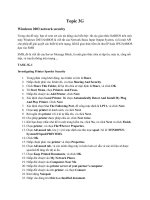Network Managerment
Bạn đang xem bản rút gọn của tài liệu. Xem và tải ngay bản đầy đủ của tài liệu tại đây (303.02 KB, 27 trang )
Network Management 9-1
Chapter 9
Network Management
Computer Networking:
A Top Down Approach
Featuring the Internet
,
3
rd
edition.
Jim Kurose, Keith Ross
Addison-Wesley, July
2004.
A note on the use of these ppt slides:
We’re making these slides freely available to all (faculty, students, readers).
They’re in PowerPoint form so you can add, modify, and delete slides
(including this one) and slide content to suit your needs. They obviously
represent a lot of work on our part. In return for use, we only ask the following:
If you use these slides (e.g., in a class) in substantially unaltered form, that
you mention their source (after all, we’d like people to use our book!)
If you post any slides in substantially unaltered form on a www site, that
you note that they are adapted from (or perhaps identical to) our slides, and
note our copyright of this material.
Thanks and enjoy! JFK/KWR
All material copyright 1996-2006
J.F Kurose and K.W. Ross, All Rights Reserved
Network Management 9-2
Chapter 9: Network Management
Chapter goals:
❒
introduction to network management
❍
motivation
❍
major components
❒
Internet network management framework
❍
MIB: management information base
❍
SMI: data definition language
❍
SNMP: protocol for network management
❍
security and administration
❒
presentation services: ASN.1
Network Management 9-3
Chapter 9 outline
❒
What is network management?
❒
Internet-standard management framework
❍
Structure of Management Information: SMI
❍
Management Information Base: MIB
❍
SNMP Protocol Operations and Transport Mappings
❍
Security and Administration
❒
ASN.1
Network Management 9-4
What is network management?
❒
autonomous systems (aka “network”): 100s or 1000s
of interacting hardware/software components
❒
other complex systems requiring monitoring, control:
❍
jet airplane
❍
nuclear power plant
❍
others?
"Network management includes the deployment, integration
and coordination of the hardware, software, and human
elements to monitor, test, poll, configure, analyze, evaluate,
and control the network and element resources to meet the
real-time, operational performance, and Quality of Service
requirements at a reasonable cost."
Network Management 9-5
Infrastructure for network management
agent
data
agent
data
agent
data
agent
data
managed device
managed device
managed device
managed device
managing
entity
data
network
management
protocol
definitions:
managed devices
contain
managed objects
whose
data is gathered into a
Management Information
Base (MIB)
managing entity
Network Management 9-6
Network Management standards
OSI CMIP
❒
Common Management
Information Protocol
❒
designed 1980’s:
the
unifying net
management standard
❒
too slowly
standardized
SNMP: Simple Network
Management Protocol
❒
Internet roots (SGMP)
❒
started simple
❒
deployed, adopted rapidly
❒
growth: size, complexity
❒
currently: SNMP V3
❒
de facto
network
management standard
Network Management 9-7
Chapter 9 outline
❒
What is network management?
❒
Internet-standard management framework
❍
Structure of Management Information: SMI
❍
Management Information Base: MIB
❍
SNMP Protocol Operations and Transport Mappings
❍
Security and Administration
❒
ASN.1
Network Management 9-8
SNMP overview: 4 key parts
❒
Management information base (MIB):
❍
distributed information store of network
management data
❒
Structure of Management Information (SMI):
❍
data definition language for MIB objects
❒
SNMP protocol
❍
convey manager<->managed object info, commands
❒
security, administration capabilities
❍
major addition in SNMPv3
Network Management 9-9
SMI: data definition language
Purpose: syntax, semantics of
management data well-
defined, unambiguous
❒
base data types:
❍
straightforward, boring
❒
OBJECT-TYPE
❍
data type, status,
semantics of managed
object
❒
MODULE-IDENTITY
❍
groups related objects
into MIB module
Basic Data Types
INTEGER
Integer32
Unsigned32
OCTET STRING
OBJECT IDENTIFIED
IPaddress
Counter32
Counter64
Guage32
Time Ticks
Opaque
Network Management 9-10
SNMP MIB
OBJECT TYPE:
OBJECT TYPE:
OBJECT TYPE:
objects specified via SMI
OBJECT-TYPE construct
MIB module specified via SMI
MODULE-IDENTITY
(100 standardized MIBs, more vendor-specific)
MODULE









